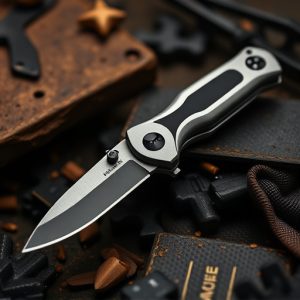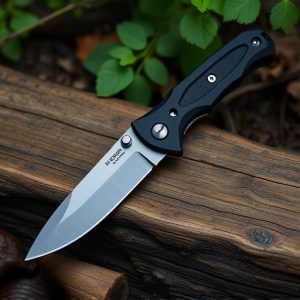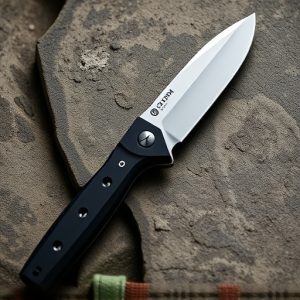Pricing Insights for OTF Automatic Knives: A Comprehensive Guide
OTF (One-Time-Flip) automatic knives are distinguished by their spring-assisted mechanisms and comp…….
OTF (One-Time-Flip) automatic knives are distinguished by their spring-assisted mechanisms and compact design, combining practicality with a sleek profile. They are constructed from high-quality stainless steel for durability and feature torsion bars or coil springs for smooth deployment, often activated with a single hand. These knives are appreciated for their balance of robust performance and ease of use in everyday tasks and tactical situations. When selecting an OTF automatic knife, it's important to consider factors like build quality, mechanism reliability, and efficiency, as well as the influence of materials, mechanical complexity, brand prestige, and legal compliance on the cost. The market offers a wide range of OTF knives, from budget-friendly options to luxury models with advanced features and collectible value, with prices reflecting these varying qualities and exclusivities. The evolution of OTF automatic knives has seen significant advancements in deployment mechanisms, safety features, and durability, impacting both their functionality and market value, especially for vintage or limited edition models. Top brands like Kershaw, CRKT, SOG, Microtech, and LionSteel offer a spectrum of OTF knives catering to different budgets and preferences. Investors should consider factors such as rarity, condition, brand reputation, and provenance when evaluating the investment potential of an OTF automatic knife, as these can affect its resale value and collectibility. The dynamic collector market for these knives is influenced by trends and economic conditions, necessitating a balanced approach for those considering an investment.
OTF automatic knives, with their seamless deployment mechanisms, occupy a niche in the world of both everyday carry and collectible items. This article dissects the factors influencing the pricing of these sophisticated tools, from mechanics to market trends. We’ll explore the evolution of design that affects their value, examine top-tier brands and models, and delve into investment aspects, including resale potential. Join us as we unravel the intricacies behind the price tags of OTF automatic knives.
Understanding OTF Automatic Knives: A Primer on Mechanics and Functionality
OTF, which stands for One-Time-Flip or Out-The-Front, automatic knives represent a unique category within the world of cutting tools. These mechanisms are characterized by their spring-assisted action, where pressing a button deploys the blade swiftly and smoothly from its concealed position. The intricate design of OTF automatic knives incorporates a narrow pivot point, allowing for a slender profile that’s both compact and efficient. The blades, typically made of high-quality stainless steel, glide with precision thanks to the torsion bar or coil spring within. This design ensures that the knife can be opened with one hand, often with a flick of the thumb, making it a practical tool for various tasks, from everyday utility to tactical applications. Understanding the mechanics behind OTF automatic knives involves recognizing the balance between durability and ease of use; these knives are engineered to offer robust performance without sacrificing functionality or comfort in handling.
When considering an OTF automatic knife, it’s crucial to assess the build quality, the reliability of the mechanism, and the efficiency of the deployment system. The price range for OTF automatic knives can vary widely based on brand reputation, blade material, and additional features such as locking mechanisms and ergonomic designs. High-end models often come with improved spring tension and smoother operation, which can justify a higher price point. Collectors and enthusiasts may seek out limited edition or custom OTF knives, which can command premium prices due to their exclusivity and craftsmanship. For those looking for a reliable and functional OTF automatic knife, it’s important to research the available models, read reviews, and consider the brand’s reputation for quality and innovation.
Factors Influencing the Pricing of OTF Automatic Knives
The pricing of OTF (One-Time-Flip) automatic knives is influenced by a multitude of factors, each contributing to the final cost that consumers encounter. The materials used in construction play a pivotal role; high-grade stainless steel or titanium components can significantly drive up prices due to their durability and resistance to corrosion. The complexity of the mechanisms within these knives, including the deployment and locking systems, adds to the cost as well. Advanced designs that offer smooth and reliable operation are often patented, and the licensing fees for such innovations are factored into the price.
Craftsmanship and brand reputation also have a substantial impact on pricing. Knives crafted by renowned manufacturers or those with a legacy of quality and performance command higher prices. Limited edition releases or collaboration pieces between knife makers and artists can further inflate the cost, as these items are often sought after by collectors and enthusiasts. Additionally, compliance with legal regulations, such as those governing automatic knives, necessitates additional investment in design and manufacturing to ensure safety and legality in various markets. These factors combined result in a diverse price range for OTF automatic knives, reflecting the value, quality, and exclusivity of each individual piece.
The Evolution of OTF Automatic Knife Designs and Their Impact on Value
The design evolution of OTF, or one-time-flip, automatic knives has been marked by a continuous pursuit of innovation and refinement to enhance functionality and appeal. Over the years, these knives have seen significant advancements in mechanisms that ensure smooth deployment at the push of a button, while also incorporating features such as locking systems for safety and durability improvements. The early models were often bulkier and less reliable, but contemporary designs have streamlined these mechanisms to offer compact, efficient, and aesthetically pleasing options for everyday carry and tactical use. These advancements have not only improved the user experience but have also influenced the market value of OTF automatic knives. As collectors and enthusiasts seek out the latest and most sophisticated models, older designs become sought after by those interested in the historical progression of knife technology, thus affecting their respective values within the collector community. The rarity and condition of a particular OTF model, alongside its historical significance, play pivotal roles in determining its price on the secondary market. Collectors often pay premium prices for vintage or limited-edition models that showcase significant milestones in the evolution of these remarkable devices. As such, the impact of design evolution on the value of OTF automatic knives is multifaceted, with historical relevance, technological advancement, and rarity all contributing to their worth.
Top Brands and Models of OTF Automatic Knives: A Breakdown of Cost and Quality
OTF, or one-time-opening, automatic knives represent a niche within the knife community that combines convenience with reliability. When it comes to top brands and models of OTF automatic knives, quality and cost are often intertwined, with prices reflecting the materials used, the precision of engineering, and brand reputation. Among the leading contenders in this market segment, Kershaw’s Blur and Emerson CQC-13X stand out for their durability and seamless operation. These models are favored by collectors and everyday carry enthusiasts alike, balancing high performance with an accessible price point. For those seeking a blend of sophistication and functionality, CRKT’s Shenanigan and the SOG FastHaven II offer robust features at a mid-range cost.
At the higher end of the spectrum, custom and limited edition OTF knives from brands like Microtech and LionSteel command premium prices due to their exclusivity, intricate designs, and exceptional craftsmanship. The Microtech Combat Troodon and the LionSteel Sperando 2 are examples that not only elevate the aesthetic appeal of an automatic knife but also offer a level of functionality that is unparalleled in the industry. These high-end models are investments, catering to collectors and connoisseurs who appreciate the artistry and innovation behind each design. When considering an OTF automatic knife, it’s crucial to assess both your budget and the intended use, as this will guide you towards a model that offers the right balance of cost and quality for your needs.
Investment Considerations: Resale Value and Collectibility of OTF Automatic Knives
When considering the investment value of an OTF automatic knife, collectors and potential buyers should pay close attention to factors that influence its resale potential. The rarity and condition of the knife play pivotal roles in its marketability. Limited edition models or those crafted by prestigious manufacturers tend to hold their value well, making them sought after by enthusiasts and collectors alike. The originality of design, the materials used, and the overall craftsmanship can enhance a knife’s collectibility. It’s also essential to consider the brand reputation and the historical significance of certain models, as these elements often contribute to their long-term value. A well-maintained OTF automatic knife from a reputable brand may appreciate over time, especially if its design becomes iconic or if demand exceeds supply in the market. Collectors often look for pieces that are not only functional but also represent a slice of knifemaking history, making the resale value and collectibility of OTF automatic knives an important aspect of investment consideration within this niche market.
For those looking to invest in OTF automatic knives, it’s advisable to stay informed about the latest trends and releases in the collector community. The condition of the knife at the time of purchase and its maintenance thereafter are critical. Minor scratches or wear can significantly impact a knife’s value, so keeping detailed records of the knife’s history and any services performed can be beneficial. Additionally, provenance—documented ownership history—can add to the collectibility and resale potential of an OTF automatic knife. As with any investment, market fluctuations should be monitored, as collector interest and economic conditions can influence demand and pricing. Therefore, a strategic approach that combines enthusiasm for the hobby with astute financial considerations is key when investing in this specialized area of collectibles.


